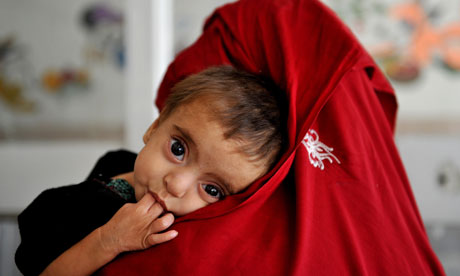Despite huge amounts of foreign aid, the levels of deprivation are similar to that found in famine zones, says UN-backed report

A UN-backed report has found almost a third of children are suffering from acute malnutrition in southern Afghanistan. Photograph: Adek Berry/AFP/Getty Images
Around a third of young children in southern Afghanistan are acutely malnourished, with a level of deprivation similar to that found in faminezones, a government survey has found, despite the hundreds of millions of dollars in foreign aid that has been poured into the region.
Around a million Afghans under five are acutely malnourished, according to the UN-backed survey. By far the worst affected area is the southern region – centred around Kandahar and Helmand – that was the Taliban's birthplace and has seen some of the heaviest fighting of the decade-long war.
"What's shocking is that this is really very high by global standards," said Michael Keating, deputy head of the UN mission in Afghanistan. "This is the kind of malnutrition you associate with Africa and some of the most deprived parts of the world, not with an area that has received so much international attention and assistance."
The Afghanistan Multiple Indicator Cluster Survey (MICS) found 29.5% of children are suffering from acute malnutrition there. A level of more than 30% among young children is considered one sign of a famine.
The data does not mean there is a famine in the south. Under UN guidelines, child malnutrition is just one of several criteria used to decide if an area is suffering a famine; others include death rates and families' access to food.
Southern Afghanistan has adequate food supplies, experts say, but a serious problem with nutrition. Some families are too poor to buy supplies while others have little education about how to nourish their children; common illnesses like diarrhoea also sap children's strength.
A major problem is attitudes to breast feeding, according to UN nutrition specialist Elham Monsef. Women are often told breast milk is not good enough or find it hard to nurse, so infants are given everything from tea and water, which have no nutritional value, to formula milk that is over-diluted or made with dirty water.
Basic health measures now common in most developing countries, such as enriching flour and putting iodine in salt to ensure healthy brain development, are not universal in Afghanistan.
On a paediatric ward at Mirwais hospital in Kandahar city children admitted for therapeutic feeding were visibly wasted, with saggy skin, protruding bones and no energy; at least one had the disease kwashiorkor, caused by lack of protein.
On a recent visit the hospital was packed with desperate mothers such as Fatima, who had travelled from the violent Helmand district of Sangin to seek help for her 18-month-old son, Saddam. At 4.4kg, he weighed the same as some newborns in the UK, and lay listlessly on a greying bedsheet he shared with another patient, his older sister and three women.
Poverty has left Fatima helpless in the face of her son's suffering. "I cannot produce mother's milk, but we are not able to buy food or powdered milk," she said. "My youngest child died from this."
Aid workers admit that although Afghanistan is well known to have chronic malnutrition problems, evidence of an extreme nutrition crisis caught them by surprise. "The numbers are just too serious to ignore," said Aidan O'Leary, head of the UN office that co-ordinates the humanitarian response to crises in Afghanistan. "It's very clear that the nutrition response as a whole has to be ramped up." He added: "This is not a one-off survey, this is a global survey conducted in conjunction with the central statistics office."
The last such survey was conducted in 2004 and although there has been a rapid escalation of the conflict since then, there has also been a huge increase in aid spending. USAID has poured hundreds of millions of dollars into southern Afghanistan, while the UK earmarked tens of millions more for development work in Helmand.
The UN and aid groups are now racing to gather more details on the scale of the problem, and worst-hit locations.
In a sign of how severe the problem is, experts warn that the crowded wards tackling malnutrition in provincial centres help only a tiny portion of families affected. "Our focus is on the acute cases, but we need to do more community outreach to prevent it," said Vidhya Ganesh, deputy head of Unicef in Afghanistan. "The major challenge for us is that therapeutic feeding (in hopsital) presents only the tip of the problem."
Maraz Gul was in the Mirwais hospital with her five-month-old baby Assadullah, who has the loose skin of an old man and wailed listlessly but non-stop as his mother talked. "I was feeding him breast milk but I couldn't provide enough, and could not afford the formula," she said.
They had endured a jolting four-hour journey from their village of Rorabad, along roads sometimes seeded with Taliban bombs, but still Maraz Gul considers herself relatively lucky compared with neighbours whose children are also wasting away.
"People in the village with this problem do not come to the hospital, they are poor women and they can't afford to pay for the vehicle," she said. "We sold a sheep to cover the cost."











No comments:
Post a Comment